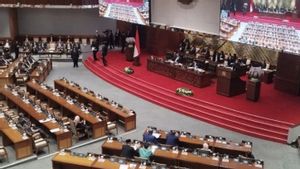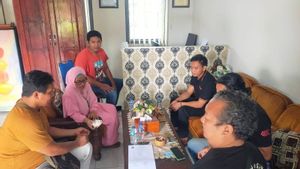JAKARTA The phenomenon of ice dew that surrounds the Dieng Plateau area, Banjarnegara Regency, Central Java, has become a public discussion. Why is the temperature so cold even though the summer is in sight?
The local community calls this phenomenon an upas dew. Quoted by Kompas, upas dew or ice dew are ice grains that appear on the surface of objects such as grass in cold areas. However, this ice dew is different from the snow in the country for four seasons.
Frozen stockpiles are a phenomenon of the emergence of ice grains on the surface, unlike snow formed as precipitated particles in the atmosphere.
Coordinator for Observation and Information of the Meteorology, Climatology and Geophysics Agency Ahmad Yani Semarang, Giyarto, said that upas dew is a daily phenomenon that is common in the dry season in Dieng.
The emergence of ice dew is a special attraction for tourists, especially those who have a hobby of climbing mountains and want to travel to witness upas dew directly. Giyarto appealed to tourists to wear clothes according to local conditions.
"Like a thick jacket or coat, gloves, socks, and shoes so that something unwanted doesn't happen during a trip," he said.
The air temperature in the Dieng area can even be below 0 degrees Celsius at a certain time.
The phenomenon of cold air, especially at night, does not only occur in the Dieng area. A number of areas in Indonesia also experienced the same thing.
In Yogyakarta, for example, the temperature can reach 17 degrees Celsius. Likewise, the Surabaya area to Bali, which is usually hot, has recently become cooler. BMKG Negara, Bali, noted that its area has reached a temperature of 21.4 degrees Celsius recently.
"The air temperature that drops drastically at night until the early hours of the morning is called the Bedding phenomenon," explained BMKG Ida Pramuwardani, Head of the BMKG Weather Prediction and Early Warning Team.
The termding itself comes from the word Javanese 'bedhidhing' absorption, which means a striking change in temperature, especially at the beginning of the dry season. This change in temperature can even reach the freezing point.
However, Ida explained that the Bedding phenomenon is actually a common thing in Indonesia and the peak occurs in the dry season, especially from July to September.
The rainy season occurs because in those months the position of the sun is at its furthest position in the north of the equator, causing the northern hemisphere to become hot and the southern hemisphere to cool down.
The islands of Java, Bali, and the Nusa Tenggara Islands, which are located south of the equator, have made this region colder than usual. In addition, the winter wind from Australia also plays a role in making Java Island colder.
Ida Pramuwardani explained that there are four factors that cause the Bedding phenomenon, namely dry air, clear skies, and topography.
Quoting BMKG, dry air in the dry season is marked by a lack of rainfall, so that the air becomes drier. Because rain rarely occurs, the sky becomes sunny.
The lack of clouds in the dry season causes hot radiation from the earth's surface to radiate into the atmosphere without a hitch and results in a significant decrease in temperature. With less rainfall, the humidity becomes low so that the water vapor near the earth's surface is also small.
SEE ALSO:
"In the dry season, the air tends to be drier due to lack of water vapor. Dry air has a lower heat capacity so that it loses heat more quickly at night," Ida explained.
In addition, the Beding phenomenon is also caused by the absence of wind that inhibits air mixing, causing cold to be trapped near the earth's surface.
In plateau areas or mountains, they tend to experience lower temperatures due to low air pressure and humidity.
The air temperature during the season of bedding can make the body cold, especially in highlands such as Dieng. The upas embus that occurs on high Dieng is often called poison because the effect of the ice dew can make the farmers' potato plants in the area die.
The Beding phenomenon is also considered to have an impact on pets and livestock. Professor of the Faculty of Agriculture UGM Yogyakarta, Prof. Kamiso NH said that disease outbreaks in fisheries often arise because they are related to the season.
In the dry season, around July to September, various diseases often appear endemic and opportunistic. For example, Aeromonas hydrotrophhila(MAS), Pseudomonas sp.(BHS), Mycobacterium sp(Mycobacteriosis), and Ichthyophthirius multifiliis(Ich).
This is due to limited water supply so that the water quality decreases, along with the low water temperature. The decrease in air temperature will reduce water temperature so that fish become stressed, appetite and endurance decrease.
The drastic change in the temperature of catfish ponds between day and night during the Beding period will cause awhitespot disease that can result in death in catfish. In addition, catfish are easily attacked by many diseases when the temperature of the pond is less than 25 degrees Celsius.
However, according to the agricultural calendar system known as the prey system, the Bedding season occurred in the Mareng-Terang period, namely during May 41 to June 21, it was considered the right time to plant palawija, nila, cotton, soybeans, and work on phunglan to plant corn.
The English, Chinese, Japanese, Arabic, and French versions are automatically generated by the AI. So there may still be inaccuracies in translating, please always see Indonesian as our main language. (system supported by DigitalSiber.id)














